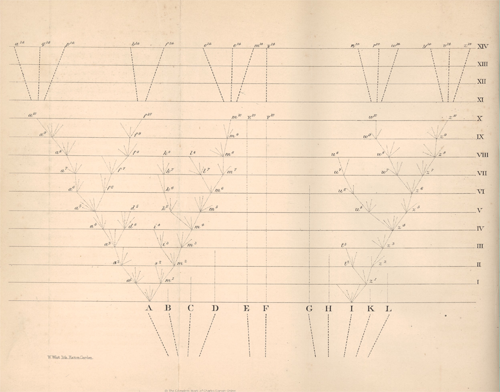As buds give rise by growth to fresh buds, and these, if vigorous, branch out and overtop on all sides many a feebler branch, so by generation I believe it has been with the great Tree of Life, which fills with its dead and broken branches the crust of the earth, and covers the surface with its ever-branching and beautiful ramifications.
It's probably the most accurate as well as beautiful, and therefore best, description of evolution and common origin that there ever will be.

Darwin's Tree of Life. Ref: www.darwin-online.org.uk.
Chapter IV is where Darwin puts forward and details his theory of natural selection, but the end of the chapter is also where he starts describing evolution as a great tree. In fact, the only illustration found in "Origin" is an abstract conceptualization of an evolutionary Tree of Life found precisely in chapter IV (show above). The passage quoted above closes chapter IV and is preceded by the following piece:
The affinities of all the beings of the same class have sometimes been represented by a great tree. I believe this simile largely speaks the truth. The green and budding twigs may represent existing species; and those produced during former years may represent the long succession of extinct species. At each period of growth all the growing twigs have tried to branch out on all sides, and to overtop and kill the surrounding twigs and branches, in the same manner as species and groups of species have at all times overmastered other species in the great battle for life. The limbs, divided into great branches, and these into lesser and lesser branches, were themselves once, when the tree was young, budding twigs, and this connection of the former and present buds by ramifying branches may well represent the classification of all extinct and living species in groups subordinate to groups. Of the many twigs which flourished when the tree was a mere bush, only two or three, now grown into great branches, yet survive and bear the other branches; so with the species which lived during long-past geological periods very few have left living and modified descendants. From the first growth of the tree, many a limb and branch has decayed and dropped off; and these fallen branches of various sizes may represent those whole orders, families, and genera which have now no living representatives, and which are known to us only in a fossil state. As we here and there see a thin straggling branch springing from, a fork low down in a tree, and which by some chance has been favoured and is still alive on its summit, so we occasionally see an animal like the Ornithorhynchus or Lepidosiren, which in some small degree connects by its affinities two large branches of life, and which has apparently been saved from fatal competition by having inhabited a protected station.
It's not only great science, it's beautiful literature.
Darwin wasn't the first to describe the relationships between species using a tree, but he was the first to present the idea of a great Tree of Life that represents the concepts of divergence, interrelatedness and common origin of all life through evolution. Still today, evolutionary trees remain the best conceptualization of evolution and of evolutionary events there is. We've taken to them so readily because they're metaphorical, allegorical, visual, and graphical, not least, while being accurate, explanatory and packed with information at the same time. Find any evolutionary story and you will find a tree describing it.
Here are my posts on "Origin" day from previous years: 150 years ago on this day... and On the Origin of Species: still going strong.
No comments:
Post a Comment
Note: Only a member of this blog may post a comment.